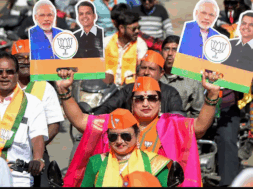
Introducing: “Footprints of Hindutva in Kashmir” by M Saleem Pandit
M Saleem Pandit’s “Footprints of Hindutva in Kashmir” is a compelling exploration of the ideological and political forces that have shaped the turbulent history of Kashmir, with a particular focus on the role of Hindutva in its integration into India. The book delves into the complex intersection of history, politics, and religious nationalism, providing readers with a detailed narrative on how the Rashtriya Swayamsevak Sangh (RSS) sought to influence Kashmir’s fate long before the region became a flashpoint between India and Pakistan.
Pandit traces the roots of Hindutva ideology in Kashmir back to the early 20th century, focusing on figures like B.S. Moonje and M.S. Golwalkar, who envisioned Kashmir as an integral part of India even in the 1930s. According to Pandit, these leaders forged ties with Maharaja Hari Singh, the Hindu ruler of Jammu and Kashmir, who was frequently criticized for his oppressive policies toward Muslim subjects, including heavy taxation and forced labor. Despite this negative portrayal in the Lahore Muslim Press, the RSS sought to project Hari Singh as a symbol of Hindu unity, reinforcing their broader agenda of a Hindu India.
One of the book’s strengths lies in its examination of Sheikh Abdullah’s political career, especially his evolving relationship with Indian leaders like Nehru and the Congress. Abdullah initially supported the accession of Kashmir to India, but as the book outlines, his aspirations for autonomy clashed with the central government’s goals, leading to increasing tensions. The October 1947 invasion of tribal militias from Pakistan and the subsequent signing of the Instrument of Accession by Maharaja Hari Singh mark a pivotal moment in the book, shedding light on the duress under which the Maharaja acted to safeguard his territory from external threats.
Pandit provides a nuanced account of the regional and international dynamics that shaped this period, with key roles played by figures like Clement Attlee and Lord Mountbatten. Their involvement, alongside Indian political leaders, helped mold the future of Kashmir, a legacy that continues to influence the region’s politics today.
The second half of the book shifts focus to the present-day implications of these historical events, particularly the ideological ambitions of the RSS and the ruling Bharatiya Janata Party (BJP). Pandit suggests that the BJP/RSS have set a goal for 2047—the centenary of India’s independence—as the deadline for transforming India into the world’s first “Hindu Rashtra.” He further speculates on the potential rewriting of India’s constitution, replacing its secular foundations with the Manusmriti text, a Hindu legal framework. This vision, according to Pandit, would mark a profound shift away from the secular democracy enshrined in India’s Constitution.
Pandit also critically examines the National Education Policy of 2020, which he interprets as an indication of Hindu nationalist influence, with its emphasis on yoga and the national anthem in schools. While India remains a secular republic in practice, with independent institutions and a judiciary that upholds religious freedoms, Pandit raises concerns about the potential erosion of these principles if the BJP’s vision comes to fruition.
What makes “Footprints of Hindutva in Kashmir” stand out is its ability to connect the dots between historical events and contemporary politics, providing a speculative yet thought-provoking analysis of where India might be headed. Pandit doesn’t shy away from addressing the challenges that lie ahead for India’s democracy and secularism, and while he presents a critical view of the RSS/BJP’s ambitions, he also acknowledges the constitutional and institutional safeguards that currently protect the country’s secular fabric.
In conclusion, M Saleem Pandit’s “Footprints of Hindutva in Kashmir” is a meticulous and well-researched book that offers a unique perspective on the ideological undercurrents driving Kashmir’s integration into India. It provides a vital historical context to the ongoing debates surrounding nationalism, religion, and politics in India. Readers interested in the region’s history, as well as those concerned about the future trajectory of Indian democracy, will find this book both enlightening and unsettling.

















